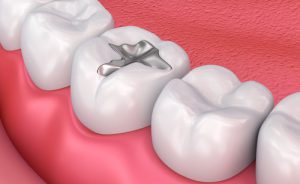Fillings

If a cavity is found in one of your teeth, either because of pain or just discovered during a regular dental cleaning, a “filling” (or restoration) will need to be placed. A filling is needed to keep the decay from spreading further through the tooth, which could lead to requiring a more involved and possibly more expensive procedure if left untreated for too long.
Sometimes, a filling can be used on cracked, broken, or worn-down tooth. It closes off the damaged area, so that bacteria can’t enter.
The best type of filling is different with each patient. Dr. Smith and Dr. Buring will help you decide which is best for you:
- Gold: Gold may last for 20 years, but they are the most expensive choice.
- Silver (amalgam): Silver is relatively inexpensive and resistant to wear but are dark in color. They are more noticeable than composite or porcelain, so are mainly used on the back teeth.
- Composite (plastic): Composite is matched to your original teeth color, but only last three to ten years, and they are prone to chip and wear when used for large fillings. They also stain easier than other types.
- Porcelain: Porcelain fillings are produced in a lab and are called inlays or onlays. They are bonded to the tooth, resist staining, and are matched to the original tooth color. This type of restoration covers most of the tooth, and the cost is similar to the gold fillings.